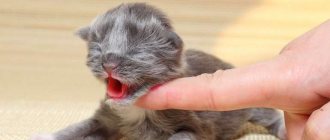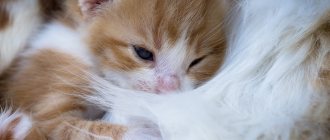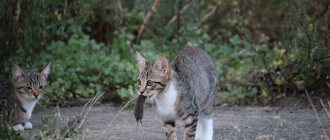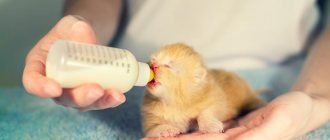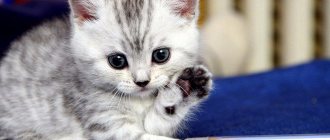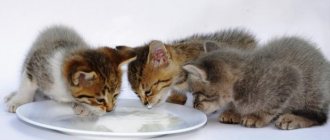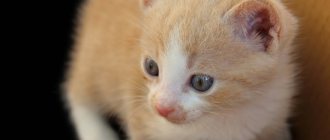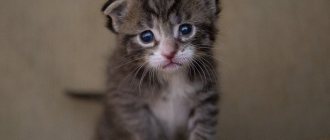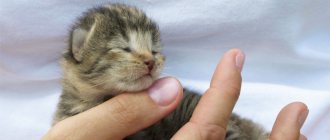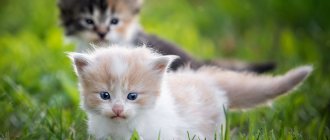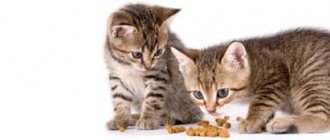How and what to feed a kitten? The first months of any animal’s life are accompanied by intensive growth of the entire organism. Genetics determines the body’s capabilities, but the extent to which these capabilities will be realized directly depends on the adequacy of the diet during the period of active growth and maturation. Any breeder knows that what is lost in the first months of life is subsequently impossible to make up.
A complete diet ensures not only the proper development of all systems and organs of the kitten, but also a sufficient level of immunity to resist diseases to which young animals are susceptible.
What is a “complete diet”?
Scientists zoologists involved in nutrition have calculated certain norms for the amount of energy and nutrients that an animal of a certain species, breed, age and sex should receive daily.
A complete diet is a diet that fully provides the animal’s body with all the substances necessary for life in the required quantity and ratio.
Based on knowledge about the nutritional needs of a kitten’s body, its physiological characteristics at a certain age and the chemical composition of food, approximate norms of a daily diet are calculated and a certain set of products is recommended for each age period of cats.
Difficulties of parenting and special skills
There are individual nuances in the issue of raising cats, especially when it comes to purebred animals. Siamese and Abyssinian cats are considered to be among the most restive. Among the hybrids, Ocicats, Bengals and jungle cats require special attention to education. Pedigree characteristics in raising kittens are mainly aimed at suppressing aggression and the desire to dominate the owner.
Before buying a kitten, be sure to discuss the characteristics of the breed with the breeder, or better yet, involve several experienced owners. Assess all the risks, especially if there are children in your family. For example, Siamese are very jealous of younger family members; they protect and protect children even from their parents. The Persian cat is naturally affectionate, calm and would rather avoid contact with the child.
Aggression in any form must be stopped immediately. Remember that a confident cat does not need to show off her physical strength. If you notice your pet's anxiety, try to find out the reasons for the discomfort. Communicate more with your ward, provide him with toys, horizontal bars and other toys. Cats that are potentially prone to aggression need to spend their energy correctly; as soon as this issue is resolved, your pet will turn into a tired, but affectionate and purring lump.
When should you start complementary feeding and how many times should you feed your kitten per day?
Experts recommend introducing complementary foods into the diet with the appearance of the first milk teeth, at the age of 3-4 weeks.
In some cases, it is necessary to start complementary feeding earlier - the cat’s milk supply is low, mammary gland diseases, multiple births, when kittens do not have enough milk and they begin to lag in growth.
In order to know whether the kittens are receiving enough essential nutrients, you need to weigh them regularly, and if they fall behind, start feeding the kittens.
When controlling your weight, take into account the following standards:
- At birth, the average weight of a kitten is 100 g, plus or minus 20 g, which depends on heredity and breed.
- After about 10 days, the weight doubles, and subsequently increases by an average of 100 g per week.
- At two months, a large breed kitten should weigh on average 1100 g, plus or minus 200 g, while male cats weigh more than female cats.
It also happens that kittens are left without a mother and the owner has to take full charge of feeding.
Frequency of feeding kittens depending on age:
- In the first 14 days of life - 10 meals;
- From two weeks to one month, reduced to 8 meals;
- By two months they switch to feeding 7 times a day;
- From the 2nd to the 3rd month they feed 6 times;
- From 4 to 5 – 5 times;
- From 5 to 9 – 4 times;
- From 9 to 12 – 3 times;
- After a year they switch to two feedings a day.
In the case of artificial feeding, from birth to one month, kittens are also fed at night. The above norms are approximate, just as the interval between feedings is approximate; small kittens themselves will let you know when it’s time to feed them, showing concern.
Praise and Punishment
Remember that by bringing a kitten into your home, you have taken on responsibility. You have committed to put up with pranks, be patient, and be there if your pet gets sick. No child was brought up without punishment to a greater or lesser extent. You, as a “parent”, must be prepared to be tough.
Until the age of six months, the kitten is not punished, but ignored. If your child has done something wrong, be offended by him, turn away, change your tone. Give your pet the opportunity to independently recognize the wrongdoing. If the ward is deliberately naughty, you have to use the “whip”.
The best way to interrupt an unwanted action is noise . Buy a regular whistle, or just clap your hands. For example, if a kitten starts scratching the sofa, clap your hands and lightly slap it with a rolled-up newspaper. After such punishment, the baby will stop unwanted actions, and when he hears the clap, he will run away without waiting for the spank.
Can it be given to kittens?
What products can be used to feed kittens if the owner prefers natural feeding for his cat?
Many foods that are acceptable in the diet of an adult animal are not recommended for kittens. This is explained by the fact that some foods are heavy for a fragile digestive system or carry a large amount of energy without satisfying the basic needs of a growing body.
The kitten’s diet should include foods that are as healthy as possible; they should be well digestible and not contain harmful substances.
Is it possible to give kittens milk?
The question implies: is it possible to give kittens what is familiar to us and most used by humans - cow's milk?
Cow's milk is not the best choice for feeding an early kitten. The composition of the milk of each species of animal is ideal for feeding its own young, but not suitable for the young of another species.
The composition and ratio of fats, carbohydrates, proteins and other chemical elements of cat and cow milk are different from each other. Cat's milk contains half the fat and 2.5 times more protein than cow's milk. It also differs in the ratio of proteins and the content of other, organic and inorganic chemical elements per unit volume.
Milk can be used in small quantities for feeding older kittens and feeding adult cats, as long as it does not cause digestive upset in the pet.
For small kittens from birth to 1 month, artificial cat milk is ideal; it can be purchased at pet stores.
Baby food (formula)
Can be used for artificial feeding of a newborn and feeding older kittens. When feeding with formulas, their concentration should be 2 times less than for children in the first week of life.
Dairy products:
Cottage cheese, sour cream, kefir, fermented baked milk, and cream are used to feed kittens in addition to meat, as a source of protein and calcium. Fermented milk products also improve the composition of microflora. You need to choose dairy products with minimal fat content.
Is it possible to give cheese?
Cheese is a healthy product, but it can be used occasionally as a treat - it contains a lot of fat.
Raw meat
It is not advisable to feed minced fish to kittens; before feeding, the fish must be boiled, and the meat either frozen or scalded.
Meat products form the basis of a kitten’s diet; preference should be given to veal, beef and chicken. You can feed lamb, rabbit meat, horse meat. It is not advisable to feed pork - it is too fatty.
Veal and beef can be used for feeding daily, choosing pieces without fatty inclusions. Give in the form of minced meat or scraps (from the beginning of complementary feeding to 7 weeks) and in the form of small pieces, no more than 1 cm, for older kittens.
If the meat is fresh, you can serve it raw, without any processing, or scald it with boiling water first.
It is better to give chicken meat boiled; raw meat may contain the causative agent of salmonellosis. You can feed it every other day.
Fish is given up to 2 times a week.
Liver
A valuable by-product, it is rich in B vitamins and iron. The liver contains a large amount of vitamin A. Kittens are given beef or chicken liver 2 times a month. In addition to the liver, it is also useful to feed other offal products - heart, kidneys, lungs. They are used more often - 2-3 times a week. Cats should not be fed spleen.
Raw or boiled egg
Use only the yolk, give it 1-2 times a week, adding it to cereals, vegetable purees or milk.
Cereals
Rice, oatmeal, semolina are used in the form of liquid porridges in milk without sugar (up to 3 months of age) or boiled in water, mixed with fish or meat: cereal - 1 part, meat - 2 parts.
Vegetables
They must be present in the diet in boiled or raw, pureed form. They are added to porridges, given mixed with yolk, meat or fish, several times a week.
Dry food
If you are an adherent of artificial nutrition, choose high-quality food for your kitten; experts do not recommend feeding kittens with food of classes lower than premium or super-premium. Start with food soaked in water. Monitor your kitten's water consumption - it should be of good quality and always available. Use dry food, alternating it with wet food from the same manufacturer, the ratio in the diet is 70% dry, 30% wet.
Food for adult cats should never be given to a kitten. Excessive doses of vitamins, macro- and microelements can lead to many negative consequences, from diseases of internal organs to poisoning with biologically active substances, which include vitamins.
What to feed newborn kittens without a cat?
The best option is a cat milk replacer. If for some reason this is not possible, you can prepare a mixture similar in composition to cat milk according to the following recipes:
- Baby formulas. Milk is prepared twice as liquid as for a baby in the first week of life.
- For 100 ml of cow's milk add one chicken yolk, 7 ml of 5% glucose and 3 drops of tetravit.
- Dilute 5 ml of cream 10% fat with boiled water in a volume of 3 ml and add 2 ml of 5% glucose.
- Goat milk mixed with water.
Change of teeth: 4 – 7 months
The process of changing teeth from baby teeth to molars most often goes unnoticed. You will not notice any gaps in your pet, and he will most likely swallow the fallen incisors.
You can determine the onset of the period by:
· redness of the gums;
· the appearance of bad breath;
· decreased appetite for meat bones.
If no other symptoms are observed, everything is normal. The situation will resolve itself when all the molars appear. You shouldn’t follow the animal’s lead and completely remove the bones; this obviously won’t do him any good.
What should kittens not be given during their growth period?
- Cow's milk is not suitable for kittens; it does not provide the body's basic needs and is difficult to digest.
- Raw river fish – causes a lack of vitamin B and helminthic infestations.
- Fermented milk and dairy products with a high fat content.
- Fatty meats, pork.
- Sausages, smoked meats, products containing salt and spices.
- Potatoes and legumes are not digestible by cats; in addition, legumes cause fermentation in the intestines.
- Flour products and sweets do not bring any benefit to the body and contribute to excess weight gain.
- Chocolate is dangerous for cats and contains a substance that is toxic to this type of animal.
Consequences of poor nutrition
Poor nutrition, especially during the growth period, is the cause of many diseases and disorders:
- Stunted growth;
- Incorrect formation of the skeleton;
- Metabolic disorders;
- Reduced immunity;
- Allergic reactions;
- Poisoning;
- Worm infestations;
- Reproductive dysfunction.
Without following the basic rules and norms of feeding, it is impossible to raise a healthy animal that meets all the characteristics of the breed.
Features of feeding kittens of different breeds
Is there a difference in feeding cats of different breeds? There is no fundamental difference, all cats are carnivores and are adapted to eating animal food, but when feeding, they take into account the propensity of a particular breed to certain nutrition-related diseases, and adjust the diet based on this.
Feeding a British kitten
Cats of the British breed are not picky in their diet, but they love to eat, and therefore often suffer from obesity. The owner should pay attention to the kitten’s weight, starting from 6 months, when intensive growth ends; if the kitten becomes overweight, select a less high-calorie diet.
Accustom your kitten to less fatty foods from childhood and do not get carried away with carbohydrates (porridge). The diet should consist mainly of protein foods, with the presence of vegetables.
Cats of this breed have beautiful thick fur. To maintain it in good condition, use vitamins and microelements that contribute to the good condition of the coat.
British kittens have a tendency to constipation; for prevention, it is recommended to use 2 ml of petroleum jelly in the daily diet.
What to feed a Scottish kitten and what to feed a fold-eared kitten?
British, Scottish and Scottish Fold kittens differ little in appearance and their feeding habits are the same. Watch the calorie intake and do not overfeed the kitten.
What to feed a Maine Coon?
The diet should always contain meat and offal.
Occasionally you can give sea fish.
In addition, chicken or quail yolk and fermented milk products are given in small quantities and infrequently.
Don't forget about vegetables.
If you prefer to feed your kitten dry food, choose a high-quality food.
Maine Coon kittens should always have water in a deep and heavy bowl; they like to rake the surface of the water with their paw before drinking.
The increase in live weight per day should average 400 g.
Feeding the sphinx
Sphynx cats have a very sensitive digestive system. It is necessary to change food or introduce new products very carefully; this is always fraught with digestive upset with prolonged diarrhea. For the same reason, sphinxes often suffer from dysbacteriosis.
The rate of metabolic microbiological processes is very high, so they have high energy needs, that is, lack of appetite, this is not about the sphinx.
There is a tendency to allergic reactions to individual proteins in meat products.
You may get the impression that these cats are omnivores, because they are ready to taste anything that doesn’t fit well, including poorly edible objects. Therefore, the owner needs to keep an eye out and not leave all kinds of chemicals and detergents, garbage, food waste and small objects in the cat’s access area in order to avoid poisoning in the pet or ingestion.
Due to sensitive digestion, food selection must be careful. When feeding sphinxes, follow these rules:
- no treats from the table;
- If dry food is used for feeding, it should only be of high quality;
- Do not use dairy products after 3 months of age;
- The basis of the diet is a variety of lean meat products and all kinds of offal. Bones need to be removed;
- Boiled sea fish is given occasionally and if there are no signs of metabolic disorders and urolithiasis, in these cases it is completely excluded;
- Many breeders advise feeding cats of this breed only natural food.
The amount of feed and feeding regimen are individual and selected experimentally.
Feeding a Bengal kitten
Feeding kittens of this breed is no fundamentally different from feeding kittens of other breeds; follow the recommendations described above.
Weeks 3 to 7
During this period, kittens begin to actively move around and explore the world around them. They are starting to teethe.
Start of complementary feeding
If the kittens have a mother who eats natural food, then absolutely nothing is required from you. Feed the cat at the same time as the litter; the babies will independently show interest in “adult” food.
For the first feeding, the standard is high-quality muscle meat with medium fat content (some parts of poultry (thigh, drumstick), beef, lamb, pork, etc.) New products must be introduced gradually and in small quantities, monitoring the kitten’s reaction. Don't introduce your kitten to a wide variety of foods at the same time, as his digestive system is just beginning to adapt to handling solid food.
It is also during this period that you can start offering meat bones, such as chicken heads. There will be no problems with digestion, since the kitten is simply not able to eat much, and at the same time he will gain experience interacting with prey.
What should not be given in complementary foods
You should not give kittens by-products (kidneys, liver and other secretions). To be on the safe side, they begin to do this after 5 or 7 weeks of practicing a raw food diet. There is also no need to start complementary feeding with fermented milk products; it is better to use them only as a reward.
Size of first food pieces
It’s better not to be shallow; the sooner the kitten begins to actively use the maxillofacial apparatus, the better. In addition, large pieces prevent the baby from choking. Therefore, give pieces the size of the animal's head.
Kitten refuses solid food
In this case, you don't need to do anything. The situation when a cat has a small litter, but only has enough milk for several of them, is quite common. As long as everyone has enough mother's milk, none of the kittens will be interested in other food.
But don't worry, milk tends to run out. Each kitten will show interest in different foods in due course. Even fairly “late” kittens, whose diet until 7 weeks consisted exclusively of cat’s milk, eventually grow large and healthy.
It makes sense to speed up the start of complementary feeding for orphaned kittens, since formula is not a complete replacement for cat milk, which is so necessary for growth. If the food does not arouse interest the first time, then try a different type of product and different cutting methods. Try to arouse interest by holding a piece of meat to your mouth and letting it smell. There is no need to force the kitten. As soon as the baby has shown interest, it is necessary to gradually reduce the amount of formula in the diet, and at 1.5 months, completely abandon it.
Ready-made food for kittens
Ready-made food is available in the form of dry food or wet food - jelly-like mousses, canned food and treats.
As already mentioned, if you do not want to risk your pet’s health, you need to choose premium and super premium food.
Cheaper feeds do not have high quality raw materials and may contain harmful preservatives and dyes, which, when used for a long time, affects the health of the animal.
To feed a kitten from 1 to 4 months, use wet mousses or dry croquettes, which are soaked in water. After 4 months, they switch to dry food; it is useful to combine it with wet food from the same manufacturer - mousses and canned food. Occasionally you can pamper an older kitten with treats.
Important! When feeding dry food, ensure the kitten has constant access to water.
Dry food for kittens
Among super-premium dry food, the following are deservedly popular:
"Royal Canin", "Purina ProPlan", "Iams/Eukanuba".
Premium dry food:
“Hills” (Hills), “Eagle Pack” (Eagle Pak), “Pro Pak” (Pro Pak), “Nutro Natural Choice” (Nutro Natural Choice).
Characteristics that you should pay attention to when selecting high quality feed:
- They do not contain soy, by-products, chemical dyes, preservatives, or odor imitators;
- Meat comes first in the description of the food composition;
- The number of additional ingredients is at least 4-5, usually 8 or more.
